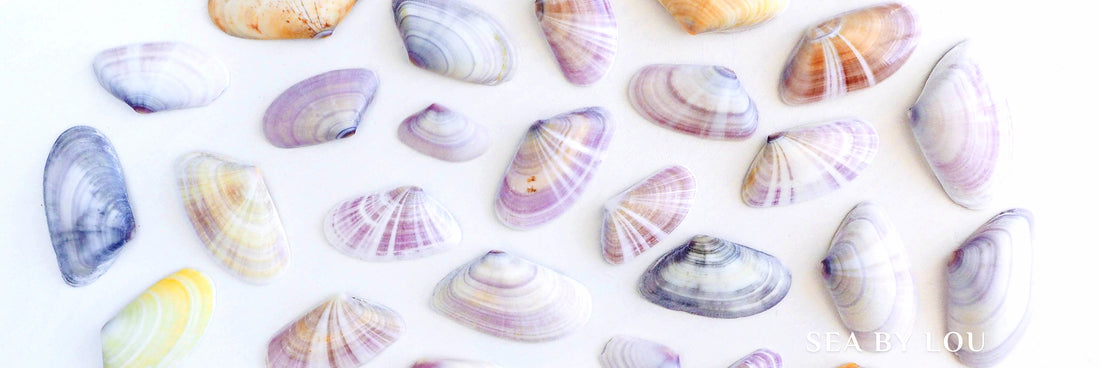
Coquina || Donax trunculus or Donax vittatus
Share
- Size: 15 to 33 millimeters
- Color: Purple, white, blue, green, yellow, pink and orange
- Family: Donacidae
- Fun fact: Coquinas are lightning-fast burrowers. When exposed to air or sensing any potential danger, these tiny mollusks can quickly dig into the sand using their strong foot, disappearing in the blink of an eye
Coquina shells are one of the shells that are commonly found along the coastline of Algarve, Portugal. Coquina shells are also known as the wedge shell, wedge clam or in Portuguese conquilha. This species has many biological names as Donax variabilis (Say, 1822), Donax trunculus (Linnaeus) or Donax vittatus (da Costa, 1778).
Donax variabilis is generally found in the southern Atlantic and Gulf shores from North America to the Caribbean. The Donax trunculus and Donax vittatus habits in the Meditterranean Sea and the eastern Atlantic Ocean, from Scandinavia to northwest Africa.
The difference in appearance between these shells is minimal and since most of the shells that I found are along the coast of Portugal, this blog will be about the Donax trunculus and Donax vittatus and use the general name coquina.
For shell collectors and beachcombers, finding a beautiful coquina shell is a joyful experience, especially when they are still attached and they look like little butterflies stranded on the beach.

Appearance
Coquinas are typically measures around 1.5 to 2.5 centimeters in length. Its shell is triangular or wedge-shaped, with fine ridges running from the top to the bottom. The annual growth rings can be seen on the shell, and these rings are often richer pigmentation compared to the rest of the shell.
Coquina shells are commonly characterized by darker zigzag stripes or bands along its surface. One of the most enchanting features of the coquina shell is its breathtaking array of colors. From vibrant shades of orange, pink, and purple to soft pastels and earthy tones. The interior of this shell can be vibrant violet, purple, white and orange.
These shells are like a painter's palette washed ashore and each discovery is a delightful surprise, celebrating the beauty of coastal diversity.

Habitat
The coquina is a species of bivalve mollusk in the order of the Donacidae family and can be found in sandy beaches along the Atlantic coasts of Europe, from Portugal to the Black Sea, and even in the Mediterranean region.

This species is primarily found in the intertidal zone, where the waves gently wash over the sandy shores. The coquina burrows into the sand, living just below the surface. As the waves recede during low tide, you may spot clusters of these small shells scattered along the beach, exposed by the retreating water.
Many empty coquina shells can be found along the coastline, attached looking like butterflies or as a single beautiful shell. Sometimes the shells are still closed, which means the mollusk is still alive and waiting for high tide to be pulled back to the ocean.
As the waves gently sweep the shores, the coquina has the remarkable ability to rapidly dig into the sand using their powerful foot, seeking refuge from potential threats or disturbances. This remarkable behavior allows them to adapt and thrive in the dynamic coastal environment.
Beyond their aesthetic appeal, coquina shells contribute to the coastal ecosystem's health. As part of the food web, for shorebirds and other marine creatures but also as a filter feeder extracting plankton. Its feeding habits play an essential role in maintaining the health of the coastal ecosystem.

Donax trunculus in G. P. Deshayes: “Hist. Nat. Mollusques t. I”, Exploration scientifique de l’Algérie, Paris 1844-1867,
Cultural tradition
Some Mediterranean countries like Italy and Spain but also in Portugal the coquina mollusk is often consumed as food as delicious seafood dishes.
In some Mediterranean cultures, coquina shells hold romantic significance. They are often exchanged as symbols of love and affection between couples, adding a touch of coastal romance to relationships. This probably because of the butterfly look they have.
If you walk along coastline of Portugal, keep an eye out for the remarkable coquinas. These little creatures play an integral role in coastal ecosystems and are a testament to the intricate beauty found in the natural world.
Interested in a beautiful piece with coquina shells? Visit my shop here.


